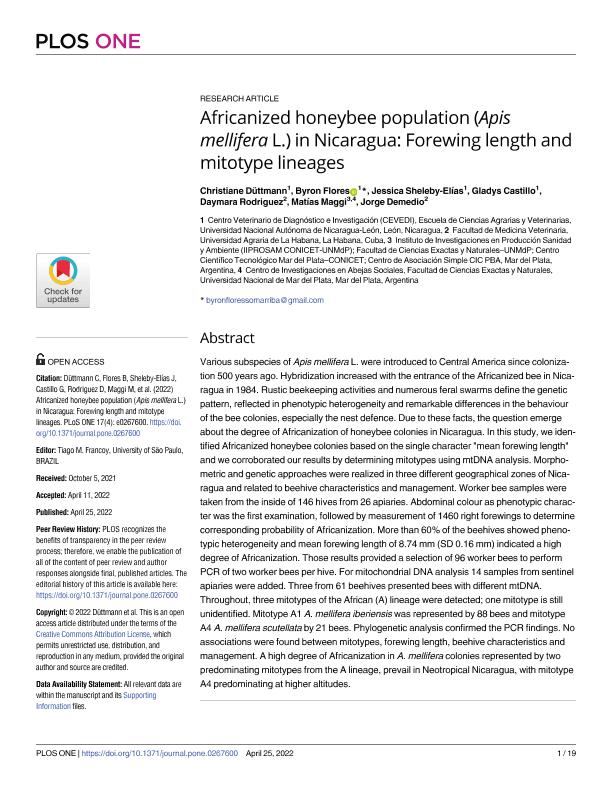Mostrar el registro sencillo del ítem
dc.contributor.author
Düttmann, Christiane
dc.contributor.author
Flores, Byron
dc.contributor.author
Sheleby Elías, Jessica
dc.contributor.author
Castillo, Gladys
dc.contributor.author
Rodriguez, Daymara
dc.contributor.author
Maggi, Matías Daniel

dc.contributor.author
Demedio, Jorge
dc.date.available
2023-09-13T10:47:40Z
dc.date.issued
2022-04
dc.identifier.citation
Düttmann, Christiane; Flores, Byron; Sheleby Elías, Jessica; Castillo, Gladys; Rodriguez, Daymara; et al.; Africanized honeybee population (Apis mellifera L.) in Nicaragua: Forewing length and mitotype lineages; Public Library of Science; Plos One; 17; 4-2022; 1-19
dc.identifier.issn
1932-6203
dc.identifier.uri
http://hdl.handle.net/11336/211306
dc.description.abstract
Various subspecies of Apis mellifera L. were introduced to Central America since colonization 500 years ago. Hybridization increased with the entrance of the Africanized bee in Nicaragua in 1984. Rustic beekeeping activities and numerous feral swarms define the genetic pattern, reflected in phenotypic heterogeneity and remarkable differences in the behaviour of the bee colonies, especially the nest defence. Due to these facts, the question emerge about the degree of Africanization of honeybee colonies in Nicaragua. In this study, we identified Africanized honeybee colonies based on the single character "mean forewing length"and we corroborated our results by determining mitotypes using mtDNA analysis. Morphometric and genetic approaches were realized in three different geographical zones of Nicaragua and related to beehive characteristics and management. Worker bee samples were taken from the inside of 146 hives from 26 apiaries. Abdominal colour as phenotypic character was the first examination, followed by measurement of 1460 right forewings to determine corresponding probability of Africanization. More than 60% of the beehives showed phenotypic heterogeneity and mean forewing length of 8.74 mm (SD 0.16 mm) indicated a high degree of Africanization. Those results provided a selection of 96 worker bees to perform PCR of two worker bees per hive. For mitochondrial DNA analysis 14 samples from sentinel apiaries were added. Three from 61 beehives presented bees with different mtDNA. Throughout, three mitotypes of the African (A) lineage were detected; one mitotype is still unidentified. Mitotype A1 A. mellifera iberiensis was represented by 88 bees and mitotype A4 A. mellifera scutellata by 21 bees. Phylogenetic analysis confirmed the PCR findings. No associations were found between mitotypes, forewing length, beehive characteristics and management. A high degree of Africanization in A. mellifera colonies represented by two predominating mitotypes from the A lineage, prevail in Neotropical Nicaragua, with mitotype A4 predominating at higher altitudes.
dc.format
application/pdf
dc.language.iso
eng
dc.publisher
Public Library of Science

dc.rights
info:eu-repo/semantics/openAccess
dc.rights.uri
https://creativecommons.org/licenses/by-nc-sa/2.5/ar/
dc.subject
AFRICANIZED BEES
dc.subject
APIS MELLIFERA
dc.subject
NICARAGUA
dc.subject.classification
Zoología, Ornitología, Entomología, Etología

dc.subject.classification
Ciencias Biológicas

dc.subject.classification
CIENCIAS NATURALES Y EXACTAS

dc.title
Africanized honeybee population (Apis mellifera L.) in Nicaragua: Forewing length and mitotype lineages
dc.type
info:eu-repo/semantics/article
dc.type
info:ar-repo/semantics/artículo
dc.type
info:eu-repo/semantics/publishedVersion
dc.date.updated
2023-08-08T12:51:18Z
dc.journal.volume
17
dc.journal.pagination
1-19
dc.journal.pais
Estados Unidos

dc.journal.ciudad
San Francisco
dc.description.fil
Fil: Düttmann, Christiane. Universidad Politécnica de Nicaragua; Nicaragua
dc.description.fil
Fil: Flores, Byron. Universidad Politécnica de Nicaragua; Nicaragua
dc.description.fil
Fil: Sheleby Elías, Jessica. Universidad Politécnica de Nicaragua; Nicaragua
dc.description.fil
Fil: Castillo, Gladys. Universidad Politécnica de Nicaragua; Nicaragua
dc.description.fil
Fil: Rodriguez, Daymara. Universidad de La Habana; Cuba
dc.description.fil
Fil: Maggi, Matías Daniel. Universidad Nacional de Mar del Plata. Instituto de Investigaciones En Produccion, Sanidad y Ambiente. - Consejo Nacional de Investigaciones Cientificas y Tecnicas. Centro Cientifico Tecnologico Conicet - Mar del Plata. Instituto de Investigaciones En Produccion, Sanidad y Ambiente.; Argentina
dc.description.fil
Fil: Demedio, Jorge. Universidad de La Habana; Cuba
dc.journal.title
Plos One

dc.relation.alternativeid
info:eu-repo/semantics/altIdentifier/url/https://journals.plos.org/plosone/article?id=10.1371/journal.pone.0267600
dc.relation.alternativeid
info:eu-repo/semantics/altIdentifier/doi/https://doi.org/10.1371/journal.pone.0267600
Archivos asociados
